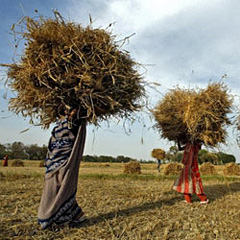 |
 |
 |
 Editorials | Environmental | April 2007 Editorials | Environmental | April 2007  
Millions Face Hunger From Climate Change: Report
 Associated Press Associated Press


| | Farmers carry wheat crop bundles in India. Warming temperatures could result in food shortages for 130 million people by 2050. Water shortages will also become more common in India as the Himalayan glaciers decline. (Rajesh Kumar Singh/AP) |
Bangkok, Thailand - Warming temperatures could result in food shortages for 130 million people by 2050 and threaten to cause drought and higher seas in Australia and New Zealand by 2030, according to a UN report released this week.

The climatic changes threaten ecologically rich sites like the Great Barrier Reef and sub-Antarctic islands, according to the latest report from the Intergovernmental Panel on Climate Change.

A summary of the full, 1,572-page document written and reviewed by 441 scientists was released Friday. The latest document, the second of four reports including the summary, tries to explain how global warming is changing life on Earth.

Further details were unveiled Tuesday in a series of regional press conferences around the world.

The report suggests that a 3.6-degree increase in mean air temperature could decrease rain-fed rice yields by 5 percent to 12 percent in China. In Bangladesh, rice production may fall by just under 10 percent and wheat by a third by the year 2050.

The drops in yields combined with rising populations could put close to 50 million extra people at risk of hunger by 2020, an additional 132 million by 2050 and 266 million by 2080, the report said.

"Unchecked climate change will be an environmental and economic catastrophe but above all it will be a human tragedy," Achim Steiner, executive director of the United Nations Environment Program, said in a statement.

"It is absolutely vital that international action is taken now to avoid dangerous climate change," he said. "Otherwise the consequences for food and water security in Asia, as for many other parts of the world are too alarming to contemplate."

Water shortages will also become more common in India as the Himalayan glaciers decline, while nearly 100 million people annually will face the risk of floods from seas that are expected to rise in Asia between 0.04 inches to 0.12 inches annually, slightly higher than the global average.

For Australians and New Zealanders, the warming temperatures will be felt mostly through more extreme weather.

"Heat waves and fires are virtually certain to increase in intensity and frequency," Kevin Hennessy, the coordinating lead author on the chapter for Australia and New Zealand, said in a statement.

"Floods, landslides, droughts and storm surges are very likely to become more frequent and intense and frosts are very likely to become less frequent," he said.

The rising temperatures, according the report, will also lead to a loss of a quarter of alpine ice mass in New Zealand, drops in agriculture production in southern and eastern Australia and eastern New Zealand as well as the spread of tropical diseases such as dengue fever.

In the South Pacific, rising seas are "expected to exacerbate inundation, storm surge, erosion, and other coastal hazards, thus threatening vital infrastructure, settlements, and facilities that support the livelihood of island communities," according to the report.

Penehuro Lefale, one of the lead authors on the small-island chapter, said in a statement the warmer temperatures will also hurt sectors ranging from tourism to agriculture and fisheries on many island nations.

"Climate change is likely to heavily impact coral reefs, fisheries and other marine-based resources of small islands of the Pacific," he said. "There is likely to be a decline in the total tuna stocks and a migration of these stocks westwards, both of which will lead to changes in the catch in different islands."

While the South Pacific islands will struggle to adapt to climate change, the report said Australia and New Zealand have "considerable capacity" to adjust.

Efforts to cut greenhouse gas emissions should be launched, however, the report predicted immediate reductions would not offset climatic changes in these countries until at least 2040.

It also called for a range of adaptive measures including limiting new building along threatened coastlines, building corridors to allow threatened species to migrate, and improving water conservation.

In the rest of Asia, the report calls for mainstreaming of sustainable development policies and including climate proofing concept in national development initiatives. It also suggest improving public food distribution networks, disaster preparedness and health care systems to reduce the vulnerability of developing countries to climate change. | 
 | |
 |



